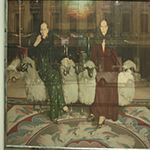Euroacademia Conferences
 Europe Inside-Out: Europe and Europeanness Exposed to Plural Observers (9th Edition) April 24 - 25, 2020
Europe Inside-Out: Europe and Europeanness Exposed to Plural Observers (9th Edition) April 24 - 25, 2020 Identities and Identifications: Politicized Uses of Collective Identities (9th Edition) June 12 - 13, 2020
Identities and Identifications: Politicized Uses of Collective Identities (9th Edition) June 12 - 13, 2020 8th Forum of Critical Studies: Asking Big Questions Again January 24 - 25, 2020
8th Forum of Critical Studies: Asking Big Questions Again January 24 - 25, 2020 Re-Inventing Eastern Europe (7th Edition) December 13 - 14, 2019
Re-Inventing Eastern Europe (7th Edition) December 13 - 14, 2019 The European Union and the Politicization of Europe (8th Edition) October 25 - 26, 2019
The European Union and the Politicization of Europe (8th Edition) October 25 - 26, 2019 Identities and Identifications: Politicized Uses of Collective Identities (8th Edition) June 28 - 29, 2019
Identities and Identifications: Politicized Uses of Collective Identities (8th Edition) June 28 - 29, 2019 The European Union and the Politicization of Europe (7th Edition) January 25 - 26, 2019
The European Union and the Politicization of Europe (7th Edition) January 25 - 26, 2019 7th Forum of Critical Studies: Asking Big Questions Again November 23 - 24, 2018
7th Forum of Critical Studies: Asking Big Questions Again November 23 - 24, 2018 Europe Inside-Out: Europe and Europeanness Exposed to Plural Observers (8th Edition) September 28 - 30, 2018
Europe Inside-Out: Europe and Europeanness Exposed to Plural Observers (8th Edition) September 28 - 30, 2018 Identities and Identifications: Politicized Uses of Collective Identities (7th Edition) June 14 - 15, 2018
Identities and Identifications: Politicized Uses of Collective Identities (7th Edition) June 14 - 15, 2018
Who Can Erase the Traces?
-
-

-
Presentation speakers
- Fortunata Calabro, Independent Researcher, London, UK
- Download presentation
Abstract:
Despite the increasing democratization that followed the long era of dictatorships, the Latin American continent continues to show the highest indices of social inequality in the world. This paper will focus on the work of the Guatemalan artist, Regina Jose Galindo (b. 1974), considering how her artistic practice responds to censorship and human rights violations, through a close engagement with “¿Quien puede borrar las huellas?” 2003 (Who can erase the Traces?). Galindo’s work intervened in the daily activity of Guatemala City and by doing so reactivated debates about economic, legal,and military processes that were undeniably problematic. The performance makes a direct comment on military violence in Latin America and is considered “a poetic metaphor for the act of inscribing inerasable memories — in this case, memories of those killed by the military.” The artist reclaims strategies belonging to a tradition of political art that was censored during the dictatorships. Over the course of the transitional periods and the recent re-democratization of Latin America, her work has been seen as an alternative to decorative and post-utopian art. Galindo tends to promote dissidence in the public sphere through the mechanism of disillusionment and disenchantment.She is intent on understanding reality as historical and conflictive rather than natural or harmonious. Indeed, through her activist performances, and by using her body, the artist recalls notions of national identity and the formation of a social imaginary.
-
Related Presentations

Identity and Self-Fashioning of an Ottoman Ruler as Shown in Gentile Bellini’s Portrait of Sultan Mehmed II (1480)
- Talitha M. G. Schepers

















